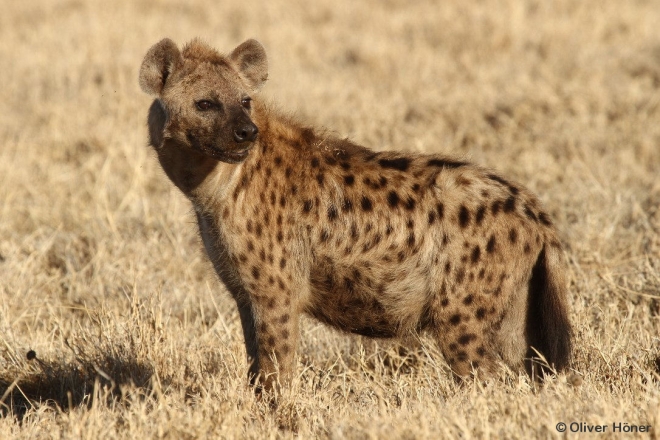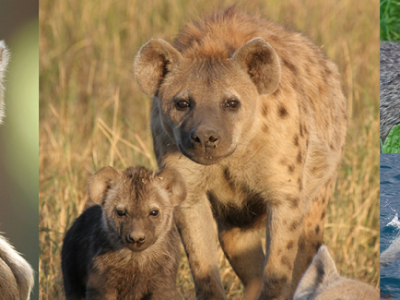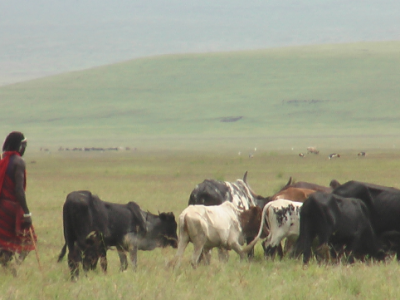Spotted Hyenas
A complex society
Appearance and specialties
Distribution
Diet
Taxonomy
Characteristics
Name: Crocuta crocuta
Head-body length: ~ 125 cm (49″)
Shoulder height: ~ 75 cm (29″)
Body mass: ~ 58 kg (127 lbs)
Gestation period: 110 days
Litter size: 1 or 2 (rarely 3)
Lactation period: 7 – 24 months
Longevity (max.): 19 yrs
Age at 1st birth (females): 2 – 5 yrs
A complex society
Spotted hyenas live in hierarchical social groups that consist of up to 130 members, including up to 50 adult females, 40 adult males and 40 offspring. In these ‘clans’ there is a strict, linear dominance hierarchy in which all females and their young dominate all immigrant males. Daughters and sons inherit the social ranks right below that of their mother. Thus, spotted hyenas live in matrilineal societies led by an ‘alpha-female’ followed by her young and all other females with their young. Below the lowest-ranking native clan member comes the highest-ranking immigrant male, followed by all other immigrant males. In exceptional cases, a male may lead a clan.
Daughters usually remain in their birth clan for life and build close relationships with their mother and sisters. This system of coalitions reinforces the social rank of individuals within the clan hierarchy. Coalitions and clan hierarchies are therefore usually stable for many years. However, when the reigning coalition of the alpha female and her allies weakens — which happens when one of the allies dies or the females of the coalition do not reproduce well — a coalition of lower-ranking females may manage to overthrow the alpha female coalition from the throne.

Females may leave their birth clan and establish a new clan when a neighbouring clan becomes extinct or vacates its territory (which is rare in intact ecosystems). The few cases observed so far indicate that young, low-ranking females are more prone to split off and establish a new clan. This may be because low-ranking females benefit more from dispersing and are more likely to know when a territory becomes vacant as they intrude more into other territories than high-ranking females.
Females may also join an existing clan, but this type of dispersal is extremely rare; in the Ngorongoro Crater it so far happened only once when three females of the Airstrip clan joined the Shamba clan.
Most sons emigrate and join another clan at the age of about 3.5 years. This contrasts with female dispersal behaviour; dispersal in spotted hyenas is therefore considered ‘sex-biased’, or more precisely ‘male-biased‘. When a male joins a new clan, he acquires the social rank at the very bottom of the hierarchy, irrespective of the social rank he occupied in his birth clan. This is due to the fact that, in contrast to most other mammals, social relationships with other males rather than body size or fighting ability determine the social rank in spotted hyenas.
New immigrant males therefore are at a disadvantage compared to already established males who are supported by their coalition partners. Once established in the new clan, immigrant males can climb the hierarchy ladder but they have to queue. Indeed, immigrant males usually only rise in rank when a higher-ranking male dies or leaves the clan. As a result, it usually takes immigrant males many years to reach the top of the male hierarchy.
Appearance and specialties
Spotted hyenas have a dog-like physical appearance. They have light-brown to dark-brown fur (with spots), a long, muscular neck, a massive skull, and round, slightly pointed ears. Their skull is characterised by a high sagittal crest to which are attached strong masticatory muscles. These provide spotted hyenas with powerful jaws that generate one of the highest bite forces of the animal kingdom.
Females and males look very much alike. In contrast to many other mammals, female and male spotted hyenas are of very similar size and appearance:
(1) Females are less than 1% taller and less than 3% longer than males.
(2) Females have masculinised external sexual organs that closely resemble those of the males:
-
-
- their urinary and reproductive tracts are fused, forming an elongated clitoris through which they urinate, copulate and give birth. This clitoris can be erected to a ‘pseudopenis’ that closely resembles the penis of a male hyena.
- their outer labiae are fused and filled with tissue, forming a ‘pseudoscrotum’ that resembles a male scrotum. They are the only mammal with no external vaginal opening.
-
Identifying the sex of young females and males based on external inspection is therefore challenging. So challenging that spotted hyenas have long been thought to be hermaphrodites. See our tips to sex hyenas >
Having a pseudopenis is costly to female spotted hyenas. In young, first-time breeding females, the first twin sibling sometimes is a stillbirth because the pseudopenis lacks elasticity. According to evolutionary theory, a structure with such fitness costs should be selected against unless it has benefits that outweigh the costs. More about the benefits of having a pseudopenis >
Hyena mothers are devoted to their cubs. Before they give birth, hyena mothers look for a birth den that is separate from the clan’s communal den and that has only one single, narrow entry. After giving birth, the mothers stay at the den for about two weeks to build a strong bond with their offspring and recognise each others ‘voices’. After these two weeks, they carry their cubs to the communal den to socially integrate them into the clan. Cubs weigh about 1.5 kg (3.3 lbs) at birth and grow very fast because they are nursed with milk that has the highest protein and one of the highest energy and fat contents of all land-living carnivores. Hyena mothers nurse their cubs for an average of 15 months! This is a huge energetic investment, especially when considering that fathers do not provide any care to the offspring.
Newborn spotted hyenas are more precocial than any other land-living carnivore. They can open their eyes at birth and their (deciduous) incisors and canines are fully erupted. During the first days after birth, they are highly combative because they want to clarify their dominance relationship as quickly as possible. This is important because like in many other societies, the social rank of a young hyena strongly influences how privileged and successful it will be later in life.
The following video shows a mother and her four-week-old cub:
Distribution
Spotted hyenas are the most abundant large carnivore in Africa. Originally distributed nearly all over Africa and Eurasia, they now only occur in sub-Saharan Africa and their distribution is fragmented. In many countries larger populations still exist in protected areas. The largest populations occur in the Serengeti-Mara ecosystem in northern Tanzania and southern Kenya (7200 to 7700 individuals) and in the Kruger National Park in South Africa (1300 to 3900 animals).
Diet
Spotted hyenas are skilled and powerful hunters that can kill a wide variety of prey. In the Ngorongoro Crater, their preferred prey are wildebeests and buffalo calves, medium-sized herbivores weighing between 50 and 180 kg. Experienced hyenas can take down prey as large as adult zebras on their own but they usually hunt wildebeests, zebras and buffaloes in groups of 2 to 30.
Spotted hyenas are endurance hunters, that is, they don’t stalk their prey like lions or leopards, but hunt it to exhaustion. They are extremely well adapted to this strategy and their hunting success is high when they manage to pursue their prey over a long distance. They have exceptional stamina and their heart is very large for their body size. Furthermore, their muzzle is long and filled with a network of small blood vessels that are exposed to the air the hyenas breathe, which cools down their body temperature in a highly efficient way. This allows hyenas to immediately start feeding on their prey after an enduring and intensive hunt – a big advantage in a world full of hungry competitors such as other hyenas and lions. And they are always hungry: they can devour up to 15 kg of meat and bones in one single meal, which corresponds to about 25% of their body mass.
Spotted hyenas are the ‘health police’ of their ecosystem. They hunt weak prey, that are for example very young, old, or sick, but they can also consume carrion in advanced state of decomposition. Their outstanding immune system and their digestive system are perfectly adapted to feeding on carrion; hyenas can devour animals that succumbed to diseases that can be deadly to other species (including humans) such as anthrax. Their powerful jaws, highly acidic stomach, and enlarged and powerful premolars further enable them to crush and digest even the largest bones, such as those of giraffes and elephants. All this makes spotted hyenas a crucial component of the ecosystem.
Taxonomy
Spotted hyenas are most closely related to genets and mongooses, and they belong to the family Hyaenidae. All together they belong to the carnivore suborder Feliformia (cat branch), sister suborder to the Caniformia (dog branch). Thus, despite their dog-like physical appearance, hyenas are more closely related to cats than dogs.
Based on genetic and morphological differences, modern-day hyenas are divided into four species: the aardwolf, the brown hyena, the striped hyena and the spotted hyena. Most closely related to each other within the hyena family are the brown hyena and the striped hyena.
There are differences between the spotted hyena populations of West Africa, East Africa, and South Africa in terms of morphology and mitochondrial DNA, but these differences are not substantial enough to consider the three populations as separate subspecies.
Further Information
Check out our list of publications
Systematic and taxonomy of spotted hyenas and carnivores: Project Open Tree of Life
Distribution and conservation status of spotted hyenas: The Red List of Threatened Species of the International Union for Conservation of Nature (IUCN).
































